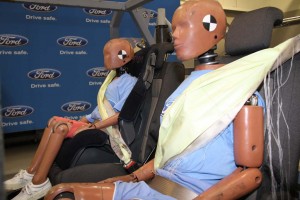
Advanced safety technology is clearly saving lives, but still more is needed. Ford plans to launch this combination airbag and seatbelt on the next-generation 2011 Explorer.
How many highway deaths are too many? At one point, not all that long ago, as many Americans were being killed on the roadways, each year, as died during the entire Vietnam War. But in recent times, the figures have begun to fall, and surprisingly fast.
As recently as 2005, the figure stood at 43,000, according to government data, but if the current run rate holds, highway deaths should dip to 35,000 for all of 2009. Yet there are those who believe even that figure can be slashed dramatically.
The automotive supplier, Germany’s Continental, has outlined its own plan, which it dubs “Vision of Zero,” something Samir Salman, CEO of the company’s American subsidiary admits “is a vision, but we can get there.” Not surprisingly, he sees the answer in the form of advanced safety technology – like the gear that Continental sells.
The automaker – or more accurately, one of the firms it has acquired – was one of the first to market with an anti-lock brake system, or ABS. The technology, designed to prevent skids, ushered in the concept of “active” safety. That was a big advanced from passive systems, such as seatbelts and airbags; while they were designed to make it easier to survive an accident, active technology hoped to avoid a crash all together.
ABS begat traction control which evolved into stability control, a technology that helps a driver maintain control even on the most slippery of road surfaces. But there’s yet another leap of automotive evolution underway and it could yield even bigger results than the technology already on the road.
The big push is for so-called ‘Driver Assistance Systems,” says Rolf Cramer, Continental’s global safety director. Such systems rely on basic technology like ABS and stability control, but add “technology enablers” like radar, sonar and video cameras that allow the vehicle to perceive and respond to the world around it, often without a driver’s involvement.
Parking sensors and rearview cameras are rapidly becoming ubiquitous. So is active cruise control, which started out as a costly option on select luxury cars. ACC uses lasers or, preferably, high-frequency radar to watch out for traffic and other obstacles. Set a speed and your vehicle will adapt, as necessary to the traffic flow.
The same basic hardware can be modified to allow a vehicle – such as the Mercedes-Benz S-Class to actually come to a complete stop if traffic slows or, with the new Volvo C30, if a distracted driver fails to notice a potential collision.
Meanwhile, video cameras are being used to advise drivers when they drift out of their lane – Toyota’s Lexus division even nudges the car back into its own lane. The latest BMW 7-Series can spot European road signs, warning a driver, for example, if they’re speeding.
Just one or two tickets, says Cramer, is enough to justify the cost of the technology. He admits that cost is the real challenge with advanced safety systems. While studies show motorists put safety among the most important factors in choosing the right car, buyers generally resist paying much if anything extra for added technology.
So, the German executive says, manufacturers face the dilemma of adding more hardware while passing little or none of the cost to consumers. And, of course, that means automakers are putting pressure on their suppliers to bring costs down.
It’s working. ABS was as much as a $2,000 option, two decades ago. Today, it’s standard on almost every vehicle. On “commodity” systems, like ABS, Cramer adds, “We have to drive down costs between 3 and 5% a year. If you’re talking new technology, we have to bring it down 10% or more.”
That reflects the general trend in electronic technology, as does the steady miniaturization of componentry. Continental’s Mark 100 controller handles the job of three separate devices from early in the decade, handling ABS-related devices, airbags and chassis controls. Yet, it’s half the size, “and reducing size also means reducing cost,” explains Cramer.
The boom in safety technology has largely been a mature market phenomenon. In emerging economies, the focus has generally been simply on making transportation affordable. But that’s changing rapidly. China, for example, has recently mandated a number of new safety – as well as emissions and fuel economy – standards.
The challenge, cautions Cramer, is finding a way to put everything from airbags and ABS to radar-guided hardware on a vehicle costing as little as $3,000 to $5,000. And the situation isn’t limited to emerging markets. Whether it’s the result of the weakened global economy or simply a desire to downsize, many consumers in major markets are also opting for smaller, less expensive vehicles, where it’s harder to bury the price tag for advanced safety systems.
How far will the push for safety go? Some experts believe the ultimate solution is the autonomous, or self-guided automobile. Both Cramer and Salman are skeptical. But the vehicles they envision will likely come close, providing technology to prevent drivers from making a mistake – but if they do, helping ensure survivability. If this scenario plays out, highway fatalities will continue to decline sharply in the years ahead.
